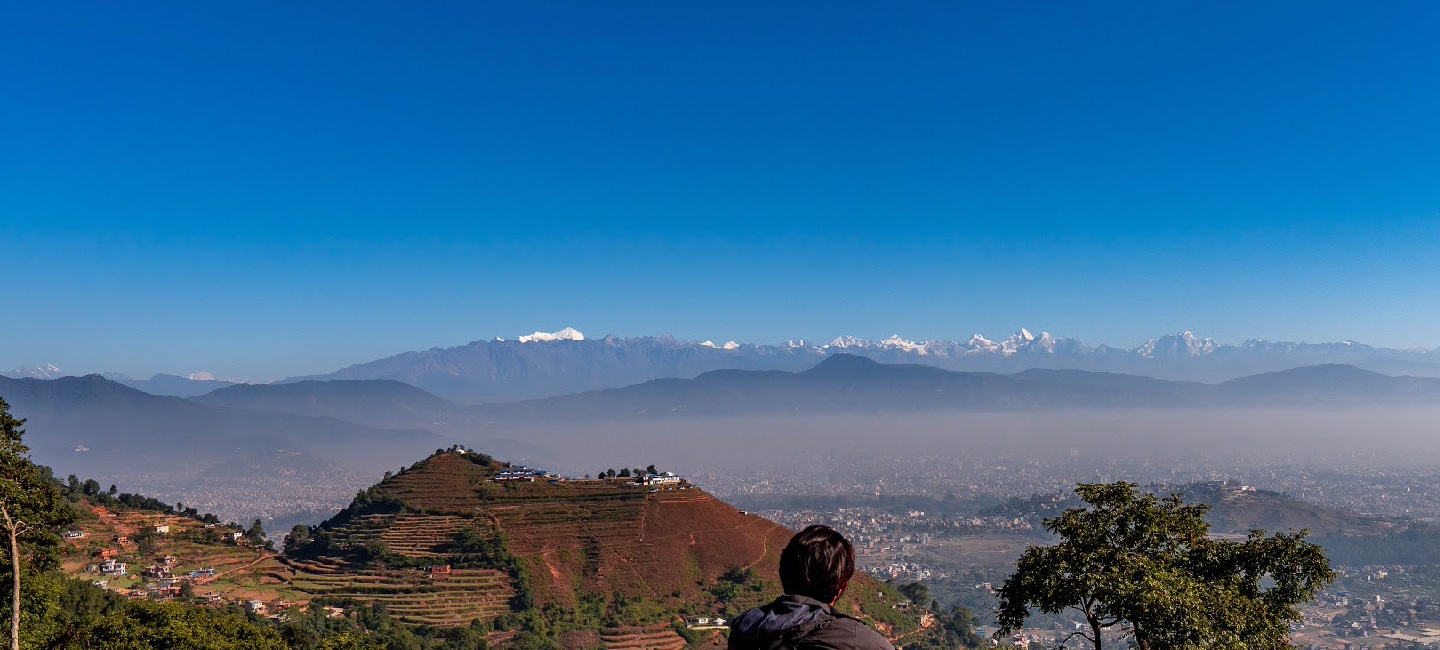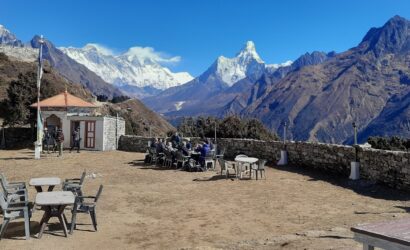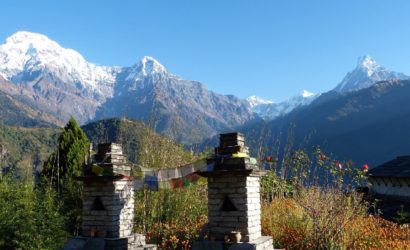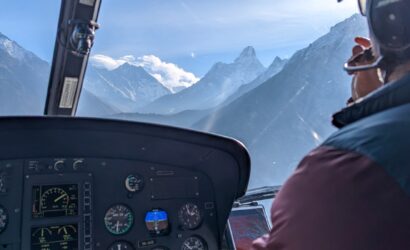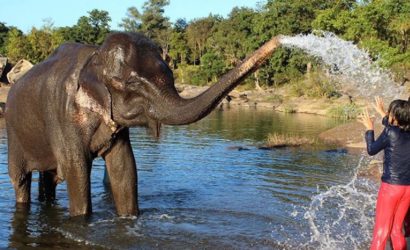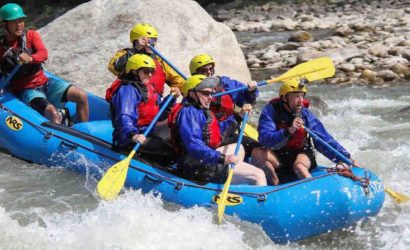Kathmandu day hike is a great opportunity to view fantastic mountain views and discover the countryside without having to lose the comfort of the city and without doing the tiring weeks long trekking.
So, If you don’t have the time or energy to go further, you can still experience hiking around the hills and small settlements of Kathmandu for one or more days. The sub-alpine woods and quiet landscape create the hustle and bustle of town life a wonderful brief break.
Kathmandu day hike is a perfect choice for those who are looking for the taste of trekking in Nepal in a day trip though, combining two things City and Nature and easy access to and from nearby Kathmandu. This hike is good for all ages.
1. Chisapani Hike
Trip Overview
- Max. Altitude : 2,215m
- Top Highlights: Views of Langtang Himal, Ganesh Himal, Jugal Himal and Gaurishankar ranges. Hiking through Shivapuri National Park sub-tropical forest.
- Hike Duration: 4 to 6 hours
Chisapani is a small settlement with fantastic views and good walking around Tamang, Brahmin, and Chetri people. The hike starts at Sundarijal about an hour from central Kathmandu, passes Kathmandu’s main water source and continues through Shivapuri National Park until you reach the village of Chisapani.
How to reach Chisapani?
Take a bus from Jamal to Chabhil (Jamal is about 10 minutes by foot from Thamel) and then change to Sundarijal at Chabhil for a bus. Or you can use a taxi to reach Sundarijal. Start your hiking!
2. Champadevi Hiking
Trip Overview
Max. Altitude: 2,249
Top Highlights: Smell of the pine forests! Stupas and monasteries.
Hike Duration: 2 to 3 hours.
Champadevi is in Kathmandu Valley’s southeastern corner and is in Makwanpur District. There are several routes to reach the summit, but one that takes you along the Dollu Valley through pine forests and the grassy ridge top is the most popular and easiest accessible route.
This route starts at Hattiban Resort and the trail is easy to follow and well trodden. The trip from the resort will take approximately three hours, back and forth. At the bottom of the steep gravel road to the resort (for larger vehicles or if you want extra walking time) or at the resort itself parking is available.
As mentioned, there are several routes and some others start from the north side of the Pharping Valley (starting from the village of Pharping) and take you north to the Champadevi summit. These routes are more difficult to identify. Bring a map and do your homework before you start!
How to reach Champadevi?
Busses leave the Old Bus Park every day (15 minutes walk from Thamel). Just go along to Dakshinkali and ask for a bus. Getting off at the Haatiban Resort road is more difficult because the driver may not know the name of the resort. If you go to Pharping or Dakshinkali, just listen to him shouting the name of the stop.
3. Nagarkot Trek
Trip Overview
Max. Altitude: 2,195m
Top Highlights: Nagarkot and its surrounding hills/valley you can see several Himalayan mountain ranges Ganesh Himal, Langtang and Everest range. Sunrise and sunset from Nagarkot.
Hike Duration: 3 – 5 hours
Nagarkot itself is 32 km east of Kathmandu and can be visited for a day, but to appreciate the beauty of the area and the views of the mountains, it is a good idea to walk around the area and stay overnight if possible.
To begin your walk, ride about an hour to Sakhu, an old Newari city on Kathmandu Valley’s southwest edge. The walk through pine woodlands requires about four hours. You can look around the town when you reach Nagarkot and watch the sunset spectacularly across the Himalayas. Then bring a cab back to Kathmandu (pre-booked) or remain overnight and walk down or catch a local bus the next day. And do not miss the dawn that is even more impressive!
How to reach Nagarkot?
Buses leave every 30 minutes from the Old Bus Park (15 minutes walk from Thamel). Take a bus from Kathmandu to Bhaktapur and from Bhaktapur bus stop take a bus to Sakhu.
4. Chisapani and Nagarkot Trek (2 nights 3 days)
To continue to go to Nagarkot the next day is a good way to expand your trek to Chisapani. Trek Sundarijal to Chisapani as described above, overnight at Chisapani then hike about 6 hours through mostly dense forest and local Tamang village to Nagarkot, where you can drive back to Kathmandu overnight.
Another alternative is to keep walking (that day or the next) from Nagarkot to Changunarayan and then drive back to Kathmandu.
The trail from Nagarkot to Changunarayan goes down through terraced fields, through a village of Tamang, and along a ridge of deciduous forest.
It takes about 3,5 hours from Nagarkot to the Changunarayan temple. This temple is a UNESCO World Heritage Site resorted to in the 2015 earthquakes after being damaged. In the Temple there is also a very interesting museum that has been cared for in love over the years.
You can walk or drive back down to Bhaktapur (8 km) from Changunarayan and discover this medieval city with its rich cultural history.
Do you have any question about trip to Nepal?
Tell us about your trip to Nepal and what you expect from it. We will answer your questions in 24 hours and help you design a trip with a comfortable itinerary to best meet your needs.
Upon your arrival in the Kathmandu airport after completing your custom formalities Visa, etc. pick up your luggage and look for our airport representative from Himalaya Discovery, who will display your name on the board at the arrival gate. You will be greeted by our representative and transferred to the hotel by private tourist vehicle.
Today is free for sightseeing in Kathmandu. You may wish to visit Durbar Square in the heart of the old city where the old Royal Palace, with its intricate woodcarving is located. The whole area is a maze of temples and images.
Leading away from the square in all directions are narrow alleys, full of the most amazing variety of shops and stalls. Some of these landmarks are considered World Heritage Sites including the historic Bhaktapur Durbar Square, the famous ‘Monkey Temple’ Swayambhunath and Buddhists shrine Buddhanath which is one of the largest Stupas in the world.
There will also be a full trip briefing today with gear check. In case you need to hire or buy equipment locally there will be time to do this today.
Drive from Kathmandu to Sundarijal takes approximately one hour and trek from Sunjdarijal to Chisapani takes about four and half hours. The trail will enter through the Shivpuri Watershed and Wildlife Reserve.
The first settlement you will come across is Mulkharka with Tamang habitants. The route heads down the ridge through a forest of oaks and rhododendron to Chisapani (2300 meters) Overnight at hotel.
Todays’ trek leads through the forest and along the ridge; with spectacular views of Annapurna, Manaslu and Ganesh Himal The walk towards Nagarkot has outstanding views of the Himalayas, the trail leads through interesting rural farm villages.
Along the ridge between the Chisapani and Nagarkot offers excellent panoramic scenery of the surrounding verdant landscapes and the snow capped mountain range. Overnight at hotel.
After the wonderful morning with grand panoramic view of the high snow capped mountain range and with the beautiful sunrise, walk leads to a descend most of the way passing through rural farm villages and friendly locals, trekking on the terraces with fabulous views of the surrounding landscapes and as far to the Bhaktapur city.
After a good walk of 3 hours reaching at our destination at Changhunarayan, Changunarayan an ancient temple, listed in the world heritage site, from here we take an hour drive back to Kathmandu, after a glorious time up in the hills.
In the evening we will have a farewell dinner in a traditional Nepalese restaurant with cultural performances.
If you are interested in continuing on to Himalaya trekking, Chitwan jungle safari, rafting, bungee jumping, paragliding, scenic Everest flight, Tibet tour, Bhutan tour.
Today is rest and relax throughout the day or say goodbye to Nepal. Enjoy your final moments in Kathmandu with a city stroll or souvenir shopping.
Our representative will meet you at your hotel and drive you to the airport for your return flight home.

